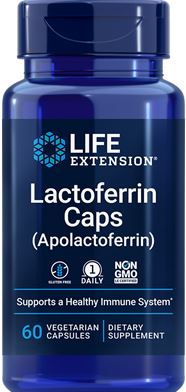Osteoporosis plagues millions of older adults, weakening bones and leading to fractures.
Our bones are constantly remodeled by removing old bone and replacing it with new bone. It’s how bones stay strong and youthful.
But as we age, the creation of new bone doesn’t always keep up with the destruction of old bone.
That’s osteoporosis, and it causes bones to become brittle, weak, and prone to fractures that can be fatal.1
It’s alarmingly common, striking 30% of women aged 50 or older and more than 77% of women over 80.
In men, about 16% of those 50 or above have osteoporosis, and more than 46% of those over 80 have it.2
Many people are careful to ensure they get enough of the building blocks of bone, including calcium,vitamins D3 and K, and other essential bone nutrients.3-8
However, building new bones is a complex operation. Research shows that a protein called lactoferrin gives bones the instructions they need to both reduce bone loss and increase the building of new bone.
The results can be dramatic. In one study, a lactoferrin combination product increased markers of bone-forming activity by 24% more than a placebo.9
Lactoferrin and Osteoporosis
plants growing in a beaker
To create and maintain strong bones, we need certain nutrients as building blocks and cofactors (or “helper molecules”).
Calcium and vitamin D3 are the best known. We also need sufficient vitamin K (which turns on bone-building proteins) and the minerals magnesium, boron,zinc, manganese, and silicon.3-8 These vitamins and minerals provide the raw material for healthy bones.
But rebuilding weak bones caused by osteoporosis requires something more.
As we age, senescent cells accumulate in our bones and throughout our bodies. These are old, unhealthy cells that can no longer divide and refuse to die off to make way for new, healthy cells.
Worst of all, they secrete harmful signaling molecules that actively weaken bones and hasten body aging.10
These signaling molecules increase the activity of cells called osteoclasts that absorb bone and decrease the activity of bone-forming cells called osteoblasts. The result: Our bones become weaker, more porous, and prone to fractures.
But lactoferrin, a protein found in milk,11 has the power to activate bone-building signals that normally shut down or weaken with age.12-18
When it comes to bone strength, one lactoferrin combination product was shown to counter the kinds of signals that result in weakened bone, meaning lactoferrin could reduce bone breakdown and increase new bone formation.9
Results of Human Studies
Human studies show how effectively lactoferrin can restore a proper, healthy balance between bone resorption and new bone production.
In one study, researchers gave healthy, postmenopausal women either a placebo or 125 mg/day of lactoferrin coupled with an enzyme from milk called ribonuclease.9
Both groups also received 100% of the recommended daily allowance of calcium.9
After 180 days, women who took the lactoferrin-ribonuclease combination had a decrease in a marker of bone-resorption osteoclast activity by 15.6% compared with placebo recipients, and an increase in markers of bone-forming osteoblast activity by 7%-33%.9
Another study examined the effect of direct application of regular lactoferrin in a rare but troubling complication of treating osteoporosis with bisphosphonate drugs, osteonecrosis of the jaw.19
In this condition, bone in the lower jaw dies for unknown reasons, often poking through the gums and skin and allowing infection to set in.20 Generally, dead bone has to be removed surgically. Then a gauze dressing is applied while the wound heals.19
In this study, researchers saturated the gauze dressing with lactoferrin and applied it after surgery, exposing the healing bone directly to lactoferrin.19
The surgical wounds healed in just one to two weeks, compared with two to three months under usual treatment,19 a dramatic demonstration of the powers of lactoferrin to drive healthy, new bone formation.
Animal studies also show that lactoferrin promotes stronger, fracture-resistant bones with increased mineral density.18,21-24 These bones have a more youthful structure, with more of the tiny “I-beams” called trabeculae that internally support bone.18,22
How Lactoferrin Strengthens Bones
plants growing in a beaker
Lactoferrin is a natural component of milk, nature’s baby food. Many of its properties promote cell growth and differentiation (when stem cells mature and develop into specialized cell types), which is required in infancy and early childhood.
Lactoferrin can promote bone health by:
Preserving bone mass and improving bone microarchitecture,22
Preventing the stress-induced death of bone-building osteoblast cells,25-27
Promoting the differentiation of stem cells into bone-building osteoblast cells, while suppressing their differentiation into bone-resorption osteoclasts,15,25-29
Enhancing the growth of new cartilage cells in-vitro, potentially benefiting joint health,26
Activating youthful signaling that stimulates growth of new bone, suppresses the death of bone cells, and promotes differentiation leading to new bone,13,18,21,24,27 and
Activating transforming growth factor-beta (TGF-beta), a signaling protein most active in youth, which promotes new bone formation.12
Researchers are continuing to investigate additional benefits of lactoferrin in promoting youthful cellular activity. But it’s already shown great promise in fighting against the bone loss that has too often been considered an inevitable part of aging.
Summary
plants growing in a beaker
Osteoporosis plagues millions of older adults, weakening bones and leading to fractures.
It’s vital to get enough of the nutrients the body uses to make strong bones, including calcium, vitamins D3 and K, as well as essential bone minerals.
But we can also correct the signals that drive osteoporosis. Lactoferrin, a protein derived from milk, may do just that: It can reduce signals that promote bone loss, and boost signals that promote bone growth.
As research into this important compound continues, lactoferrin may well take a prominent place among the more familiar bone-building nutrients.
In case you do not know, the primary benefit of lactoferrin is to enhance healthy immune responses.
|








Reviews
There are no reviews yet.